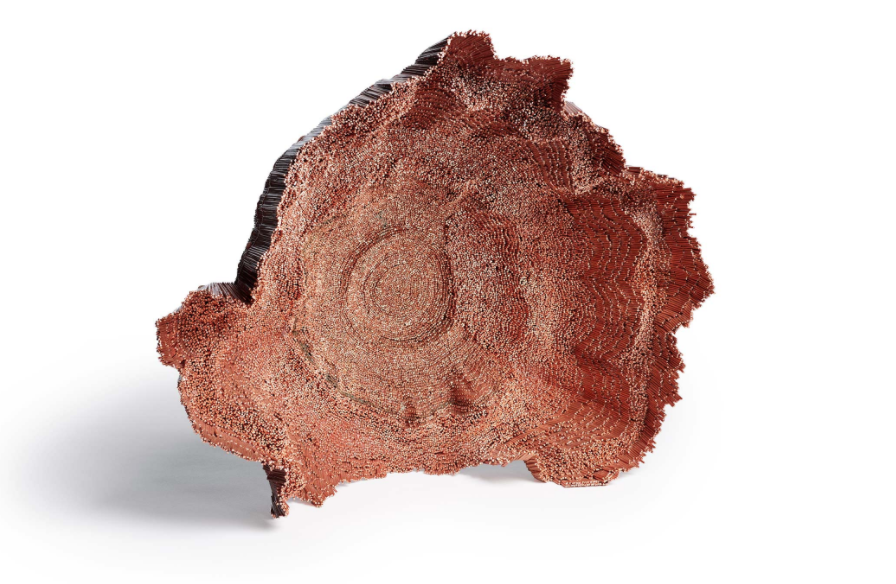Chinese artist Lin Fanglu wins the Loewe Craft Prize
2021
Jonathan
Anderson, artistic director of the firm, highlights the ability of the winner
to "take tradition, craftsmanship, and make it abstract"
CARLOS
PRIMO
Madrid - 25
MAY 2021 - 16:16 GMT+8
This Tuesday, the work that won the prize of the fourth
edition of the Loewe Foundation Craft Prize, the world's most important craft
prize for excellence, is an installation that, from the distance, looks like a
huge rocky cloud hanging from the wall, half meter from the ground. Being
closer, however, allows us to appreciate that, in reality, it is a prodigious
amalgam of embroidery, lace and other textile works that, mixed and
superimposed, seem almost blurry, as if time had brought them together in a
natural way.
The piece, called SHE, was created in 2016 by Chinese
artist Lin Fanglu. "What caught the jury's attention was this idea of taking the tradition of
craftsmanship and making it abstract," says Jonathan Anderson, artistic
director of Loewe and member of the contest jury, in a videoconference
interview, chaired by Anatxu Zabalbeascoa and with members as prestigious as
Benedetta Tagliabue, Patricia Urquiola, Deyan Sudjic or Naoto Fukasawa.
“The scale of the piece is very unusual, and it creates
the feeling of being absorbed by some kind of abstract landscape. It was
something that a large part of the jury had never seen, and that novelty was a
very important element of the decision”.
For Lin Fanglu, born in 1989, living in Beijing is not incompatible with looking at the rural world. To create this work, she went to Yunnan, a mountainous province in southwest China, home to several ethnic minorities. "I have been thinking about traditional crafts from the perspective of contemporary art for years," she explains to EL PAÍS by email. "I have visited Yunnan many times to understand the conditions in which its inhabitants live and the traditional dyeing techniques of the Bai minority."

The winning piece, titled 'SHE', by Chinese artist Lin
Fang
The winning work is the result of that dialogue, but also
of a much more intimate aspect: the personal, physical gesture of the
craftsman. "Dyeing and knitting are practices that combine rationality and
sensitivity, mind and body," explains the artist, who spent three months weaving,
knotting, embroidering and folding white cotton to compose the piece.
“The existence of individuals, the traces of their body,
the perception of human nature and the expression of the will and the ego are
reflected in the gestures of the hands, connecting body and art. Doing it by
myself allows me to reflect the reality of my spirit”. SHE, therefore, is not a
display of rural textile techniques, but rather a sculpture that, hung on the
wall, allows us to talk about concepts and intimacy, about life and the body.
Anderson points out in turn: "Something very fascinating is happening in the world of textile crafts." He adds: “There is something delicate and extraordinary about the ability to use it to create shapes like this. It brings out new questions and opens new frontiers. That's what matters".


The two finalists for the Loewe
Craft Prize. Above, creation of Takayuki Sakiyama; below, by David
Corvalán.LOEWE
The fourth edition of the contest has been marked by the
pandemic. The awards ceremony should have been held in 2020 in Paris, but its
directors decided to postpone it until the situation began to normalize.
Finally, this year it has not been possible to organize an exhibition with the
30 finalists either, although the formula chosen by the Loewe Foundation has
something of a hybrid: the public can virtually visit, through a website, a
virtual reconstruction of the Musée des Arts Décoratifs de Paris in which the
selected works appear. The awards ceremony, presented by actor Josh O'Connor,
was broadcasted live through the company's social networks. In addition, at the
same time, The Room has been launched, a database that uses the works selected
in the different editions of the contest as a starting point to map the most
contemporary and experimental crafts in the world.
Loewe's artistic director declares: "This is clearly
an alternative solution, because the ideal would have been to present the works
in the museum, but the world as it is, is difficult." The designer says:
“The team has worked very hard to find a way to reflect the scale of the objects
as a whole. Of course, we hope to hold an exhibition in the next edition. But
surely we will use this digital format as a complementary support”.





